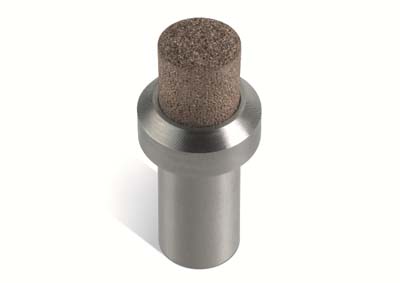hDD and cDD Dressing Tools
hDD and cDD Dressing Tools
Meister has introduced a new series of hDD and cDD stationary dressing tools that provide comparable benefits for aluminum oxide and other conventional wheels on grinding machines that are not equipped with a rotary dresser.

A couple of years have passed since Meister Abrasives USA Inc. introduced its hDD (Hybrid Diamond Dressing) and cDD (Hybrid matrix with CVD diamond inserts) technologies for the rotary dressing of high-performance superabrasive grinding wheels. Those dressing technologies have been used extensively to true and sharpen CBN and diamond wheels so that they last longer, stay sharper and perform better using rotary dressing tools that require no periodic reconditioning.
Now Meister has introduced a new series of hDD and cDD stationary dressing tools that provide comparable benefits for aluminum oxide and other conventional wheels on grinding machines that are not equipped with a rotary dresser. Early users of these products report that they are obtaining sharper, faster cutting wheels that last longer with stationary dressing tools that do not have to be relapped or returned to the manufacturer for repositioning of the diamond insert.
Meister's advanced dressing tools rely on an advanced hDD bonding matrix that combines the toughness of metal bonding with the natural porosity of a vitrified bond structure, comparable to the porosity found in vit CBN grinding wheels. The many advantages of this combination include more efficient dressing cycles that lead to more consistent conventional grinding wheel performance, increased intervals between dresses, improved longevity of the dressing tool itself, and total elimination of the need to change out the dressing tool for re-conditioning.
The new stationary cDD dressing tools have CVD (Chemical Vapor Deposition) diamond inserts strategically located within the bond structure to reinforce the dressing tool. As a result they hold an edge or profile as well as, or better than, typical handset dressing tools while providing all the advantages of Meister's hybrid-bond diamond matrix. CVD is ideal for truing applications because it provides wear resistance, cutting efficiency and thermal conductivity superior to natural or polycrystalline diamond inserts. The inserts can be engineered to any size and shape and are strategically located for optimal profile reinforcement. The microcrystalline structure of CVD inserts readily breaks down for continuous self-sharpening. In addition to obtaining better dressing performance with conventional grinding wheels, other users have discovered that it is now possible to use superabrasive wheels for the first time on their conventional grinders without rotary dressing.
Bruce Northrup, Vice President and General Manager of Meister Abrasives USA said, "These customers may only have occasional uses for CBN or Diamond wheels and this low volume does not justify the purchase of a rotary dresser. Others are interested in seeing if they can develop a super-abrasive manufacturing process that will improve their quality and productivity, before they invest in the more expensive grinder or rotary dresser. I would not tell these users that the stationary tool will allow them to forget about rotary dressing. However it does, in many instances, provide better than acceptable results for users who are not ready to invest in rotary dressing equipment."
Meister sales engineers are prepared to help users select a stationary hDD or cDD dressing tool that is right for their application. These products are competitively priced and available in all standard stationary dresser configurations.





